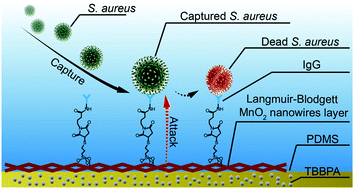Capture and elimination of Staphylococcus aureus based on Langmuir–Blodgett MnO2 nanowire monolayer promotes infected wound healing†
Abstract
Infections caused by Staphylococcus aureus (S. aureus) have a significant contribution to delayed wound healing, and thus raise a particular public health concern. Controlling the interaction between bacterial and tissue cells is considered as a key factor to affect the critical colonization and spreading invasive infection. Thus, we designed and fabricated a manganese dioxide nanowire monolayer based on the Langmuir–Blodgett method. The nanowire monolayer was functionalized by and transferred onto the surface of a tetrabromobisphenol A (TBBPA)-embedded polydimethylsiloxane (PDMS) membrane. The as-prepared composite membrane could decrease the bacterial invasion by capturing and killing the bacteria on its surface. An average capture efficiency of 90% was observed. 87% of the captured bacteria were killed according to the extended release of TBBPA from the PDMS membrane. The results from in vivo experiments demonstrate that the as-prepared antibacterial membrane could promote the infected wound healing in a mouse model. This IgG-functionalized MnO2 nanowire-coated TBBPA-embedded PDMS membrane appears promising in potential clinical applications against external infections caused by S. aureus.



 Please wait while we load your content...
Please wait while we load your content...